When the world locked down in March 2020, a surprising trend emerged. Google searches for “bread” hit an all-time high. Sourdough starter inquiries spiked 200% in just days.
This wasn’t just a passing hobby. Millions turned to baking as a calming ritual. They transformed kitchens into mini artisan bakeries.
From New York’s Bien Cuit Bakery reporting a 500% jump in starter orders to global yeast shortages, sourdough became a symbol of resilience during uncertainty.
Baking sourdough isn’t just about the perfect crust—it’s a dance of science and patience. That bubbly starter, a living ecosystem of wild yeast and bacteria, needs precise care. It needs temperature control and daily feeds.
Yet its unpredictability is part of its magic. Home bakers discovered how nurturing this culture mirrored nurturing their own routines. They turned flour and water into something nourishing and shared.
Even today, sourdough’s legacy endures, bridging ancient traditions with modern kitchen creativity. Whether you’re perfecting your first loaf or experimenting with bread pudding recipes, sourdough’s story is one of connection.
Key Takeaways
- Sourdough’s pandemic-era popularity reflects its role as a calming, hands-on activity.
- A sourdough starter’s health depends on environmental factors like temperature and humidity.
- Bakers worldwide turned to sourdough during lockdowns, driving shortages of commercial yeast.
- Sharing starters fosters community, linking home cooks across generations and borders.
- Sourdough’s tangy flavor and airy crumb reward patience, making it a gateway to artisan baking.
The Ancient Origins of Sourdough Bread Making
Imagine someone leaving flour and water out, only to find a bubbly, tangy loaf days later. This accidental fermentation started sourdough, a tradition over 5,000 years old. It shows how this ancient craft turned into the bread we love today.
Discovering Fermentation: A Happy Accident
Historians say sourdough started in ancient Egypt around 3000 BCE. Bakers found that flour and water, left alone, turned into risen bread. This bread making method spread, becoming a key part of diets.
By 1500 BCE, Egyptians were experts in this traditional baking. They made loaves that powered empires.
From Ancient Egypt to San Francisco: The Journey of Sourdough
As empires grew, so did sourdough’s reach. Greeks and Romans took on Egyptian methods, and medieval Europeans improved them. By 1849, California’s Gold Rush miners brought starters in leather bags, earning the nickname “sourdough.”
By the 1890s, San Francisco’s Boudin Bakery kept its starter alive through disasters like the 1906 earthquake. Today, their 150-year-old “mother dough” is a symbol of survival.
How Traditional Methods Survived Industrialization
When commercial yeast came in the 1800s, many turned to it. But artisans kept sourdough alive. The 1980s saw a comeback for authentic flavors, and the 2020 pandemic boosted baking worldwide.
This journey shows that every sourdough loaf connects us to centuries of human creativity. It also offers a healthier way to eat.
The Science Behind the Perfect Sourdough
Understanding baking science reveals the magic of sourdough. This ancient bread relies on a living ecosystem. Wild yeast and lactobacillus bacteria work together. Yeast turns sugars into gas for rise, while bacteria add flavor and preserve the bread.
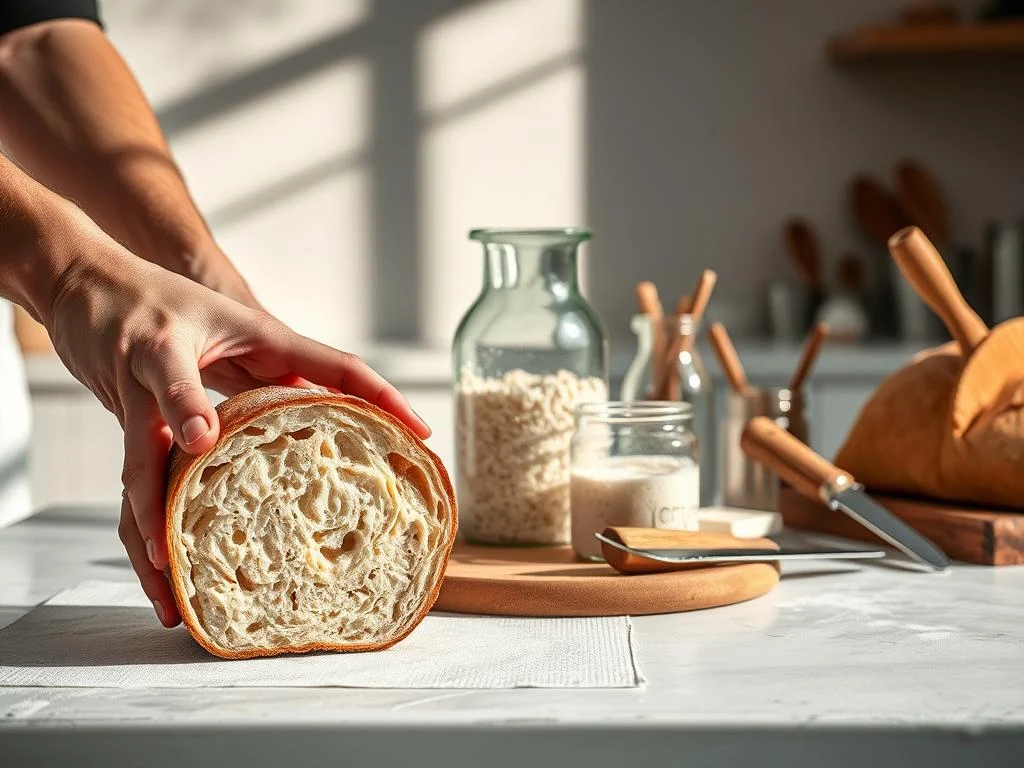
“The reality of a sourdough starter is as dynamic as a living organism.”
A healthy starter has a 100:1 bacteria-to-yeast ratio. Temperature and hydration levels control the process. Warmer environments speed up fermentation, and hydration affects dough structure. Here’s how to adjust these variables:
- Optimal temperatures: 75–85°F (24–29°C) for yeast activity
- Flour type: Rye flours start starters faster than wheat due to more complex sugars
- Acidity: A pH below 4.2 stops harmful microbes, extending shelf life
Wild yeast can’t handle maltose, but bacteria break it down into lactic acid. This acid also softens gluten, making sourdough easier to digest. The 1971 discovery of Lactobacillus sanfranciscensis showed how local microbes shape flavors. Even small changes, like retarding proofing in a fridge, can enhance tanginess or texture.
Mastering these principles turns baking into a living experiment. Want more ideas? See how microbes improve other treats here. Remember, your sourdough is as unique as your signature.
What Makes Sourdough Bread Different from Regular Bread
Sourdough bread is special because of its unique taste and texture. It’s made differently than regular bread, thanks to a slow process called fermentation. This process involves wild yeast and bacteria, which changes the bread’s flavor, texture, and even its nutritional value.
“Sourdough bread differs from regular bread mainly because of its special fermentation process. This uses natural yeast and bacteria, giving it a unique taste and texture.”
Comfort Food Cook explains that this method also makes sourdough easier to digest and has less impact on blood sugar levels.
The Unique Fermentation Process
The making of sourdough starts with a live culture, your starter. This culture ferments for 12–24 hours. This slow fermentation breaks down gluten and phytic acid, making the bread easier to digest. Regular bread, made with commercial yeast, rises much faster, missing this important step.
This slow process gives sourdough its rich and complex flavor. The result is a loaf that’s full of depth and taste.
Flavor Profile: That Distinctive Tangy Taste
The taste of sourdough comes from wild yeast and lactic acid bacteria. This taste can vary from mild to strong. Things like the health of your starter, the temperature, and the type of flour used all play a part in the flavor.
Unlike regular bread, sourdough doesn’t have a uniform taste. Each loaf is unique, reflecting the conditions of your kitchen.
Texture and Crust Characteristics
Sourdough is known for its chewy crumb and crunchy crust. The long fermentation time strengthens the gluten, making the bread chewy. The acids in the dough create air pockets, adding to the bread’s texture.
Baking techniques, like using a Dutch oven or scoring the dough, help achieve this perfect texture. Regular bread, with its shorter rise, has a denser crumb and softer crust.
Learning to make sourdough takes time and practice. But the effort is worth it. Every step, from feeding your starter to shaping the dough, contributes to a loaf that’s more than just food. It’s a symbol of patience and tradition.
Health Benefits That Have Made Sourdough a Modern Favorite
Choosing sourdough bread means more than just taste. It’s about a loaf made for health. The slow fermentation process unlocks nutrients and eases digestion. For a complete meal, try serving your loaf with these garlic-brown sugar chicken thighs.
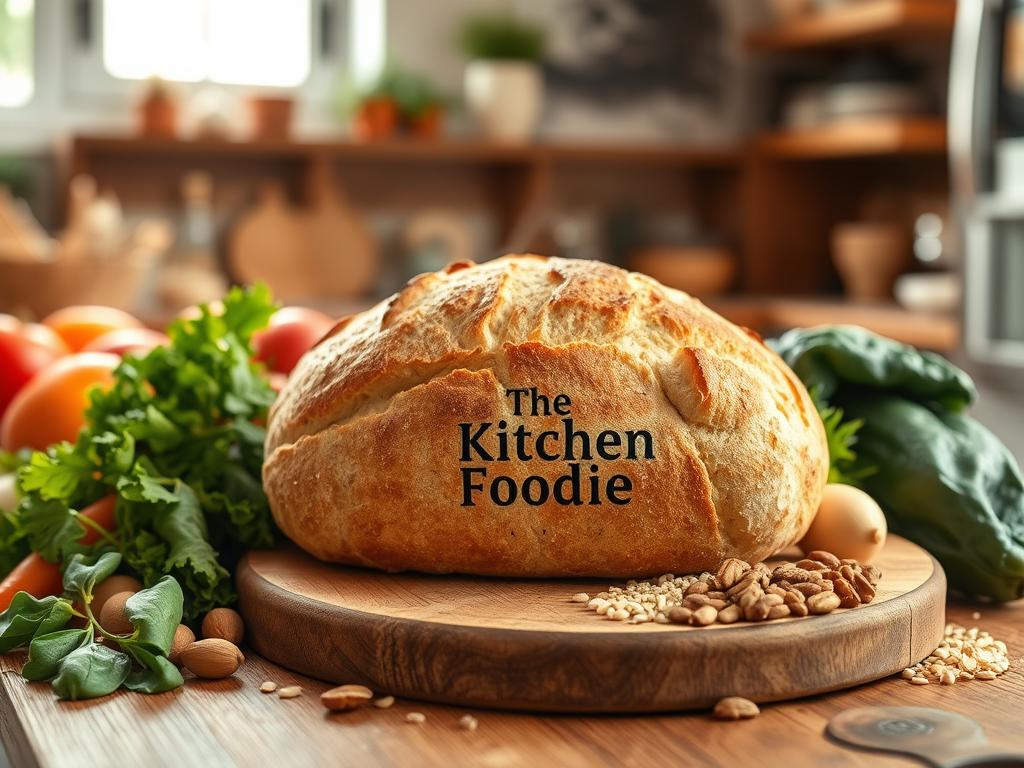
Digestibility and Gut Health Improvements
Traditional sourdough fermentation cuts phytates by 62%, easing mineral absorption. The lactic acid bacteria pre-digest starches and proteins, making the bread gentler on sensitive stomachs. Studies show this process also boosts probiotic-like effects:
- Reduces gluten proteins into smaller, easier-to-digest fragments
- Activates enzymes that break down anti-nutrients like lectins
- Supports gut flora with natural prebiotics
While not gluten-free, this process makes it more tolerable for some with sensitivities—but always consult a dietitian if you have celiac disease.
Lower Glycemic Index for Blood Sugar Management
Sourdough’s acidity slows carbohydrate absorption, lowering insulin spikes. Clinical trials show its glycemic impact is up to 30% lower than white bread. This makes it a smarter option for balanced energy levels:
- Acetic acid delays sugar release into the bloodstream
- Long fermentation creates resistant starches that slow digestion
- Participants in studies saw 22% lower insulin responses compared to commercial breads
Increased Nutrient Availability Through Fermentation
Slow baking unlocks nutrients locked in whole grains. Fermentation boosts vitamin retention and mineral bioavailability:
- 3x more B vitamins retained compared to fast-yeast breads
- Unlocks 13% of daily iron and 32% selenium per slice
- Phytase enzymes free up magnesium, zinc, and calcium trapped in grains
Every loaf offers bread nutrition benefits modern diets often lack. By embracing sourdough, you’re choosing a tradition that aligns science with sustenance—perfect for busy kitchens seeking both flavor and nourishment.
Creating Your Sourdough Starter: The Living Heart of Sourdough Bread
Starting your own sourdough starter is like welcoming a new member to your kitchen. This living culture needs patience and care. It turns simple flour and water into the heart of many baking adventures. Your starter will be your partner in every creation, from classic loaves to creative recipes.
Start by mixing 1 cup (120g) of whole grain flour (like Bob’s Red Mill for its wild yeast) with ½ cup (120ml) of filtered water, such as San Pellegrino. Stir until it’s smooth, like pancake batter. Then, cover it loosely and let it sit at 70-75°F (21-24°C).
Daily care is crucial:
- Feed it twice a day with ½ cup flour + ¼ cup water, discarding half the starter each time.
- Look for doubling in 6-8 hours—a sign of active yeast. If you see dark liquid (hooch), it’s hungry—feed it right away!
- After 7 days (or up to 12 in cooler climates), do the “float test”: a spoonful should float in water. If it sinks, keep feeding.
Storage tips: Keep active starters at room temperature, fed daily. For longer storage, refrigerate and feed weekly. Even neglected starters can revive with fresh feedings—just like old friends waking up after a nap.
With this foundation, your starter becomes a family heirloom. Use it to make loaves, pancakes, or even pizza dough. Each feed makes it stronger, bringing you closer to baking mastery. Remember, consistency is key. Your starter thrives on routines, just like your favorite recipes do. Happy nurturing!
Essential Equipment for Baking Restaurant-Quality Sourdough at Home
Mastering sourdough bread needs the right tools. Your kitchen can become a professional bakery. Here are the essentials that make a difference without costing too much.
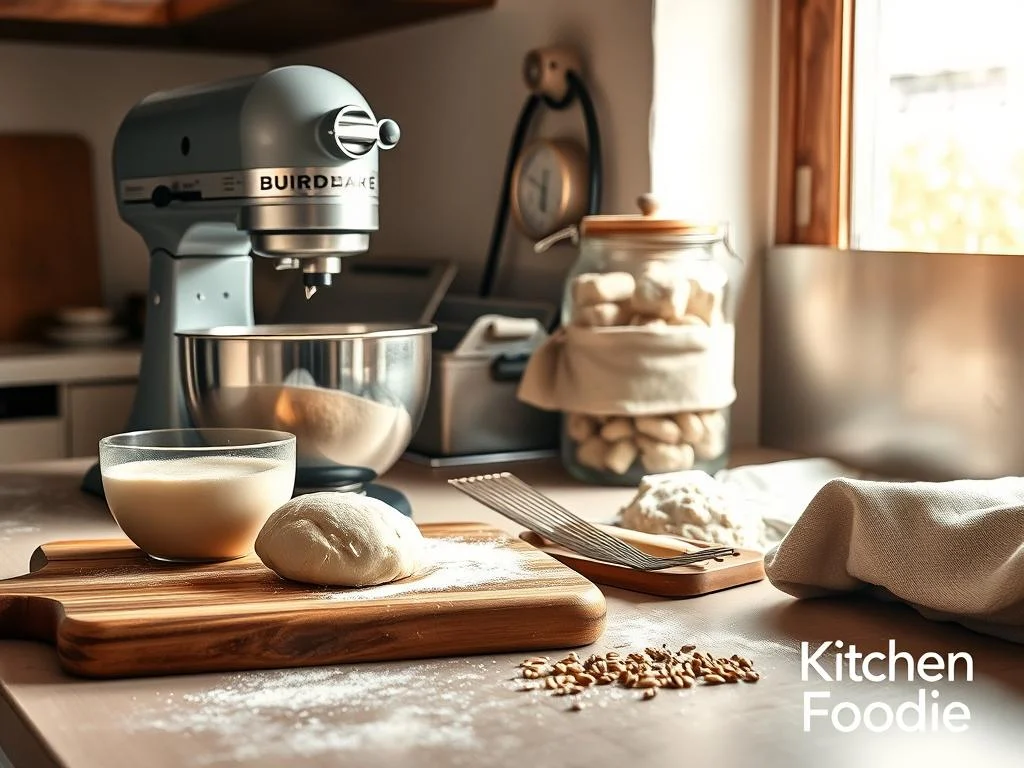
Dutch Ovens: The Key to Professional Crust
A cast-iron Dutch oven changes the game for bread baking. Its thick walls trap heat and moisture, like commercial ovens. Look for enameled or cast-iron options like Lodge’s 3-quart cooker ($39). Preheat it upside-down to 475°F before adding your dough. Sharp knives are key for scoring with a lame (try a $12 scoring tool or repurpose an offset spatula).
Specialized Tools That Elevate Your Loaf
Bannetons (8–10” wide) keep dough’s shape while proofing. King Arthur’s silicone versions are reusable and easy to clean. For scoring, a flexible sourdough equipment like a bench scraper ($10) works if you lack a specialized lame. A digital scale ($20 Escali Primo) ensures precise measurements, critical for sourdough’s finicky hydration levels.
Smart Alternatives for Budget Bakers
- Use a 4-quart Cambro container ($24) as a proofing bowl instead of a banneton
- Score dough with a razor blade or sharp paring knife
- Line a casserole dish with foil to replicate Dutch oven steam
- Repurpose a cooling rack for drying starter feedings
Start with core items like a scale and Dutch oven, then build your baking tools over time. Even a $5 bench scraper and $9 flour sack towels dusted with rice flour help with sticky dough. Remember: technique is more important than gadgets. But the right tools make your sourdough starter dreams come true!
Master Baker Techniques: Developing Your Sourdough Skills
Building sourdough techniques requires practice. But, making small changes can turn good loaves into great ones. Start by mastering stretch and fold sequences. Do four gentle folds every 30 minutes during bulk fermentation.
This method replaces kneading. It builds dough structure and keeps fermentation gases in.
- Temperature control: Keep dough at 78°F (25°C). Ambient temps should be between 74–76°F (23–24°C). Use a thermometer to track progress.
- Scoring artistry: Sharp, confident slashes let dough expand freely. Practice patterns like “elephant’s ear” cuts for even rise.
- Hydration awareness: A 72% hydration dough needs precise scaling. Use a kitchen scale for 811g bread flour, 38g starter, and 375ml water.
Develop baking skills by observing dough’s “tell-tale signs.” Look for a 50% volume increase, not a full double, and a slightly domed surface. Cold proofing for 24–48 hours enhances flavor—perfect for busy schedules. Pair this with seasoning strategies to elevate your bread recipes with herbs or sea salt blends.
Track levain ratios: 20.3% levain (38g starter + 38g flour/water) ensures consistent rises. When scaling, divide 1,800g dough into two loaves for even baking. Remember, precision matters—use a scale for accuracy. With time, you’ll intuitively “read” dough readiness through touch and sight, not just timers.
Troubleshooting Common Sourdough Challenges
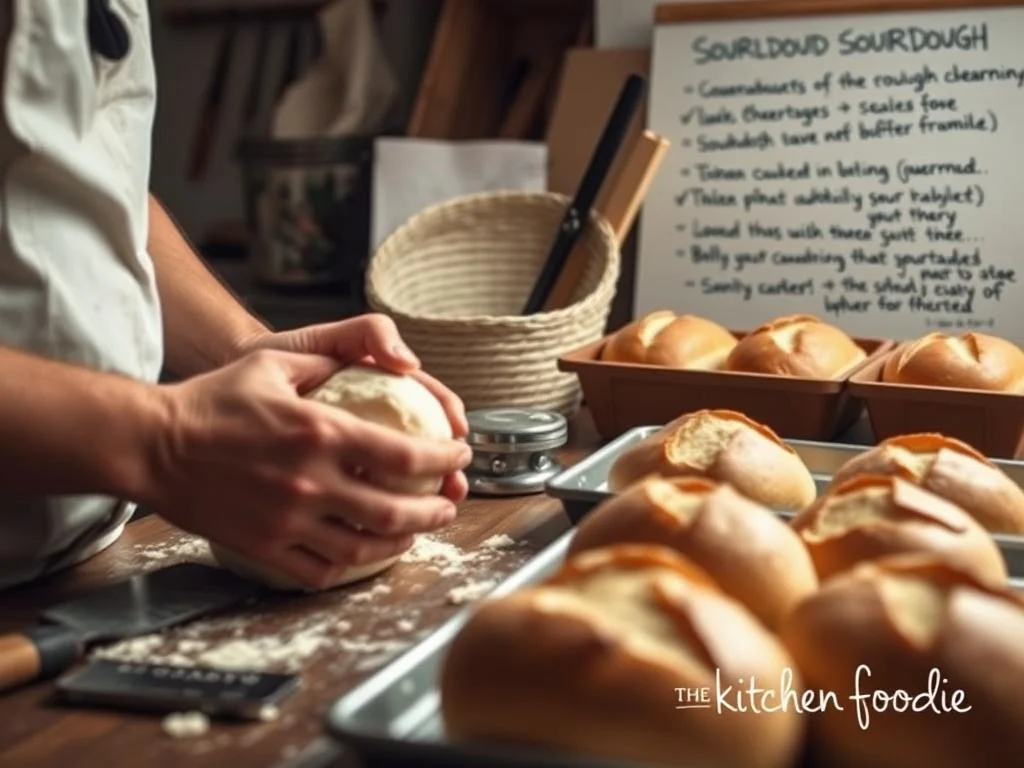
Mastering sourdough takes patience and practice. But, common baking problems like slow starters or dense loaves don’t have to stop you. We’ll explore solutions using baking techniques and science-backed strategies.
When Your Sourdough Starter Isn’t Bubbling
A weak sourdough starter often means it’s not getting enough food or care. Start by changing how you feed it:
- Feed twice daily with equal parts flour and water (e.g., 30g starter + 100g water + 100g flour)
- Add rye flour to feedings to help it grow
- Keep it at 75-80°F to help yeast grow
If your starter has liquid and sediment (hooch), feed it right away. After 7 days of regular care, most starters come back to life. A healthy starter smells tangy, not bad.
Addressing Dense or Flat Loaves
| Issue | Solution |
|---|---|
| Under-proofed dough | Extend bulk fermentation by 2-4 hours |
| Low hydration | Add 10-15% more water to dough |
| Poor shaping | Practice developing surface tension during folds |
Use the poke test: dough should slowly rebound when lightly pressed. Overproofed dough deflates easily—bake within 24 hours after shaping.
Managing Overly Sour or Bland Flavors
Adjust fermentation time and temperature to balance sourdough flavor:
- Cooler temperatures (65-70°F) reduce acidity for milder taste
- Shorten bulk fermentation by 2 hours to cut sourness
- Use bread flour (12.7% protein) for better structure and balanced flavor
For intense tang, ferment at 80°F for 12+ hours. Try different hydration levels—higher hydration (75-80%) brings out sour notes, while lower hydration (65%) softens the flavor.
Every bread recipe is a chance to learn. Check out Pantry Mama’s guide for detailed solutions. With practice, you’ll overcome setbacks and achieve sourdough success!
Seasonal Variations: Adapting Your Sourdough Bread for Different Climates
Mastering sourdough bread across baking seasons means understanding how temperature impacts bread fermentation. As Andrew Lubrino notes, even small temperature shifts can alter dough behavior. Let’s explore how to tweak sourdough techniques for summer and winter success.
“A kitchen’s environment is your partner in baking, not a barrier.” — Sourdough tradition
Summer Baking Adjustments
Hot weather demands precision to prevent over-proofing:
- Reduce dough hydration by 2% (e.g., from 76% to 74%)
- Use cooler water (45–50°F) to achieve ideal dough temp (70–75°F)
- Shorten bulk fermentation by 2–4 hours using fridge rests
- Test dough with the poke test: if indentation springs back quickly, chill the dough
Winter Fermentation Strategies
Cold weather requires nurturing microbial activity:
- Warm starter feedings with 85°F water, 1–2 hours before mixing
- Increase starter quantity (double from 50g to 100g) and reduce liquid by 25g
- Use oven heat (150°F with a pilot light) for proofing
- Optimize hydration: add 2% extra water if flour dries out
| Challenge | Summer Fix | Winter Fix |
|---|---|---|
| Fermentation Speed | Lower hydration, cooler water | Warmer feedings, extra starter |
| Proofing Time | Shorten by 25% with fridge pauses | Extend by 50% with heat sources |
| Starter Maintenance | Reduce feeding frequency by 1/3 | Feed daily with 1:2:3 ratios |
Remember, baking in winter requires patience—let dough proof overnight in a 68°F room. With these bread recipes hacks, you’ll enjoy consistent loaves year-round. Adjust, adapt, and embrace the rhythm of your kitchen’s climate!
Global Sourdough Traditions: Recipes From Around the World
Exploring sourdough recipes from different cultures shows how bread traditions shape every loaf. From San Francisco’s iconic sourdough, tied to the Gold Rush era, to Ethiopia’s injera, each recipe has a story. San Francisco’s style shows how baking styles adapt to local climates and ingredients. Its airy texture comes from cool coastal fog and rye-based starters.
- Ethiopian Injera: A spongy flatbread made with teff flour, symbolizing communal meals.
- Danish Rugbrød: Dense rye sourdough with caraway seeds, designed for cold-weather resilience.
- Turkish Bazlama: Historically sourdough-leavened, now often mixed with commercial yeast for modern kitchens.
- Mexican Birotes: Flavored with beer, lime, and spices, reflecting local fermentation creativity.
These sourdough recipes show how geography affects ingredients. Mediterranean loaves like Italian pane pugliese have open crumb thanks to long fermentation. Russian borodinski bread uses molasses and caraway, honoring historical battles. Even small changes, like substituting flours or adjusting hydration levels, highlight regional baking styles.
“Sourdough is a living history,” says master baker Clara Müller. “Its flavors carry centuries of adaptation and community.”
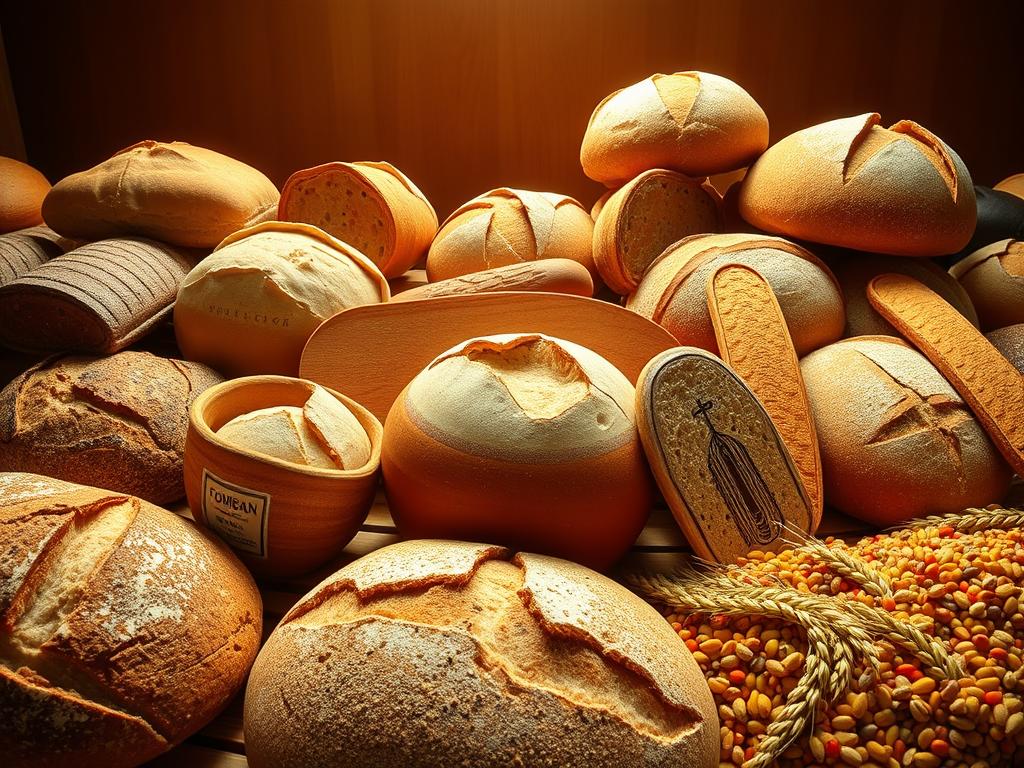
With over 40 sourdough varieties documented—from German bauernbrot to Egyptian eish merahrah—home bakers can experiment without pressure. Our guide simplifies techniques like overnight fermentation or using Dutch ovens, making global bread traditions accessible. Whether crafting a sweet chocolate chip loaf or a traditional French levain, these recipes celebrate diversity while staying practical. Let’s keep learning from cultures who’ve mastered patience and creativity in every rise.
Creative Additions to Elevate Your Basic Sourdough Recipe
Make your sourdough special with the right baking additions. You can add savory flavors or sweet surprises. For tips, check out PantryMama’s guide on mixing in ingredients.
Herb and Cheese Mastery
Start by mixing fresh herbs like thyme or basil into the dough early. This ensures they spread evenly. For cheese, grate harder types like parmesan for a smooth melt. Soft cheeses like brie work best when layered during shaping.
Remember, use 1–2 tablespoons of dried herbs for every 500g of flour. Don’t add more than 15% of dough weight in cheese to avoid a soggy crumb.
- Rosemary and pecorrino: Stir in during bulk fermentation for even flavor
- Garlic chive and gouda: Layer into folds for visual contrast
Sweet Sourdough Innovations
Make your sourdough into a dessert with chocolate, citrus zest, or dried cranberries. Add 2 tablespoons of honey to balance out tartness. If using moist ingredients like banana puree, reduce water by 2 tablespoons.
Try a cinnamon-pecan swirl or orange-cardamom with raisins for a seasonal twist. Always test how much water you need with new ingredients. Soak nuts or dried fruits before adding them to the dough. Add mix-ins 30 minutes into bulk fermentation to keep the bread light.
Beyond the Loaf: Other Delicious Things to Make With Your Sourdough Starter
Using your sourdough starter doesn’t have to stop at bread. sourdough discard recipes let you turn leftover starter into tasty treats. You can bake quick meals or try bread alternatives. Every bit of your starter can be used in amazing ways. Let’s explore the possibilities!
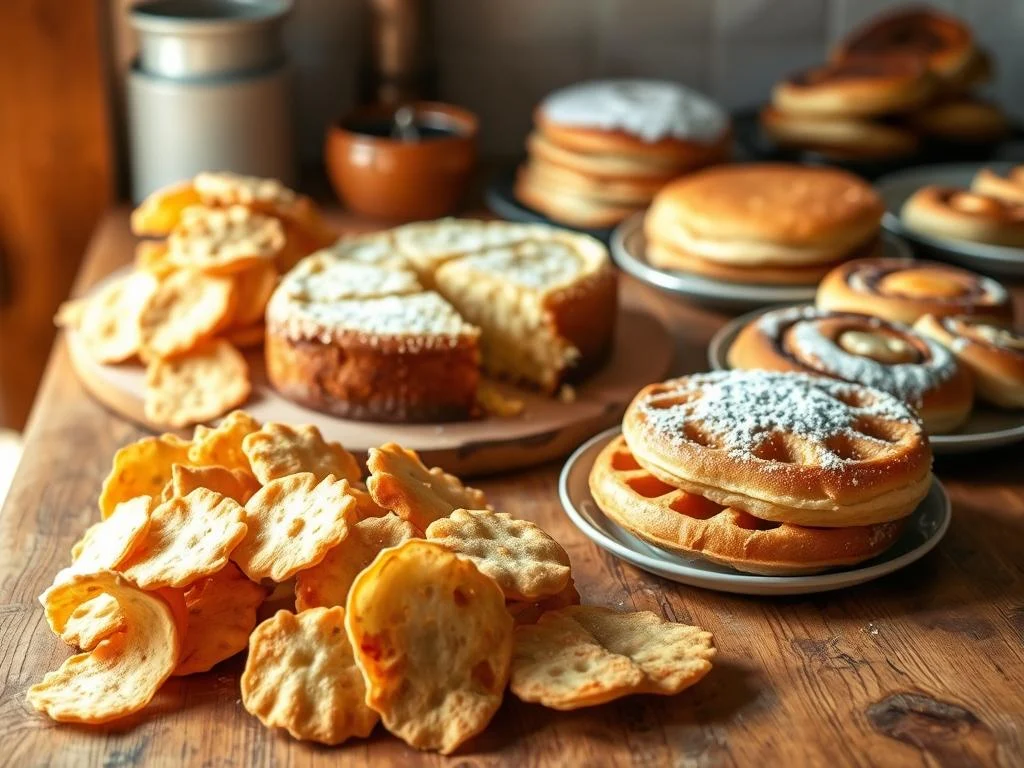
- Pancakes & Waffles: Swap buttermilk for discard in batter for fluffier results. Try our lemon-zested version or add blueberries for a sweet-tangy twist.
- Crispy Crackers: Mix discard with whole grains for savory crackers. Top with everything bagel seasoning for a crunchy snack.
- Muffins & Muffin-like Treats: Chocolate chip muffins or banana bread mini-loaves use discard for moisture and depth. Add candied ginger for an extra kick.
- Pizza & Flatbreads: Make thin-crust pizza or naan with discard for a subtle tang. Pair with caramelized onion and cheddar for a quick dinner.
When baking with starter, remember: fresh herbs enhance flavor, and moist add-ins like blueberries should be limited to 20% of flour weight. For example, 500g flour allows 100g berries. Always mix add-ins 30 minutes after kneading to avoid overworking dough.
Explore more ideas here or try our favorite: fluffy pancakes made with overnight discard mix. Every batch reduces waste and elevates flavor—because no starter should go to waste!
The Sourdough Community: How Bread Making Connects People
Sharing sourdough starters is more than just flour and water. It’s a tradition that creates baking connections. For centuries, communities have come together through bread making. Today, sourdough sharing programs are thriving online and offline, showing that baking bread together brings people together, even when we’re apart.
Starters passed between friends form living networks. A single starter can split into dozens, each carrying the story of its beginning. This act of sourdough sharing echoes ancient times, when village ovens were social centers. Now, bakers join local co-ops or online forums, sharing tips and solving bread problems.
So, why is this important? Because the bread community turns a solo activity into a shared joy. Here are ways to connect:
- Join a neighborhood bake swap or online group
- Host a virtual loaf-exchange night
- Donate extra loaves to local charities
As starters grow, so do friendships. Every rise in dough shows the growth of trust and teamwork. Whether through online chats or kitchen meetups, sourdough shows us that food is more than just food—it’s a way to connect people.
Conclusion: Why Sourdough Bread Continues to Capture Our Hearts and Kitchens
Sourdough bread has been loved for thousands of years. It’s a mix of old traditions and new science. Wild yeast and lactobacilli work together to make it delicious and healthy.
Making sourdough bread is more than just baking. It’s a slow process that makes the bread better for you. Studies show it can help control blood sugar and improve digestion. It’s like a piece of history that’s good for you.
Learning to make sourdough teaches you patience and focus. It’s about the journey, not just the end result. Unlike fast, mass-produced bread, sourdough is made with care and love.
Whether you’re starting out or getting better at making sourdough, it connects you to a long line of bakers. It’s not just about the taste; it’s about health, tradition, and feeling fulfilled. So, get ready to make your own sourdough and join a tradition that’s both old and new.
FAQ
What is sourdough bread?
Why has sourdough become so popular recently?
How do I create and maintain a sourdough starter?
What is the difference between sourdough bread and commercial yeast bread?
What are the health benefits of sourdough bread?
How can I troubleshoot dense or flat sourdough loaves?
What are some seasonal tips for baking sourdough?
Can I customize my sourdough bread recipe?
What are some common uses for sourdough starter discard?
How does sourdough connect people in the community?
Source Links
- https://www.refinery29.com/en-us/2020/03/9596438/sourdough-bread-with-starter-baking-trend
- https://electricliterature.com/why-is-everyone-suddenly-obsessed-with-sourdough/
- https://www.youkneadsourdough.com.au/blogs/sourdough-stories/the-history-of-sourdough-the-rise-of-sourdough-bread?srsltid=AfmBOoo_8R8Tj8Rxogi0Ir1lCY0GGiIQ2P7Iu9xHW5el20FoMbkR4TrC
- https://www.pantrymama.com/history-of-sourdough-bread/
- https://www.seriouseats.com/sourdough-starter-science
- https://yoursourdoughstart.com/science-of-sourdough-bread/
- https://homesteadingfamily.com/true-sourdough-bread-vs-commercially-prepared-bread/
- https://www.theclevercarrot.com/2014/01/sourdough-bread-a-beginners-guide/
- https://www.kitchenstewardship.com/food-for-thought-health-benefits-of-sourdough/
- https://www.healthline.com/nutrition/sourdough-bread
- https://pmc.ncbi.nlm.nih.gov/articles/PMC10399781/
- https://www.theclevercarrot.com/2019/03/beginner-sourdough-starter-recipe/
- https://www.feastingathome.com/sourdough-starter/
- https://littlespoonfarm.com/essential-tools-equipment-for-sourdough-bread-baking/
- https://alexandracooks.com/2019/11/05/essential-equipment-for-sourdough-bread-baking/
- https://www.thekitchn.com/sourdough-essential-equipment-23005121
- https://www.theperfectloaf.com/beginners-sourdough-bread/
- https://alexandracooks.com/2017/10/24/artisan-sourdough-made-simple-sourdough-bread-demystified-a-beginners-guide-to-sourdough-baking/
- https://www.abeautifulplate.com/sourdough-bread-troubleshooting-guide/
- https://www.theperfectloaf.com/21-common-sourdough-starter-problems-with-solutions/
- https://www.allrecipes.com/article/sourdough-mistakes/
- https://www.theperfectloaf.com/how-to-bake-sourdough-bread-in-summer/
- https://pastryartsmag.com/general/sourdough-secrets-how-colder-weather-affects-sourdough-baking/
- https://www.pantrymama.com/sourdough-bread-recipes/
- https://grantbakes.com/11-traditional-sourdough-breads-from-around-the-world/
- https://globalbakes.com/classic-sourdough/
- https://homesteadandchill.com/sourdough-add-ins/?srsltid=AfmBOoqhVPVcqurJhseh45UyCel38rOJfalR9mH4zB9SQeZDUFugMCXt
- https://food52.com/blog/25521-additions-to-sourdough-bread-ideas?srsltid=AfmBOoqxX57dAeQD1ZsN5Z7N-55VP040olHNx15GJnUsZwP_nEtJGWyK
- https://www.theclevercarrot.com/2021/06/how-to-add-fillings-olive-sourdough-bread-recipe/
- https://countryroadssourdough.com/21sourdoughaddins/
- https://homegrownhappiness.com/12-delicious-sourdough-recipes-using-sourdough-starter/
- https://thedomesticman.com/2020/05/03/community-sourdough-bread/
- https://www.catholicmom.com/articles/sourdough-bread-and-the-kingdom-of-god
- https://www.christopherroosen.com/blog/2021/11/21/psychological-benefit-of-making-sourdough
- https://www.mccormick.com/articles/food–wine/everything-you-ever-wanted-to-know-about-sourdough













